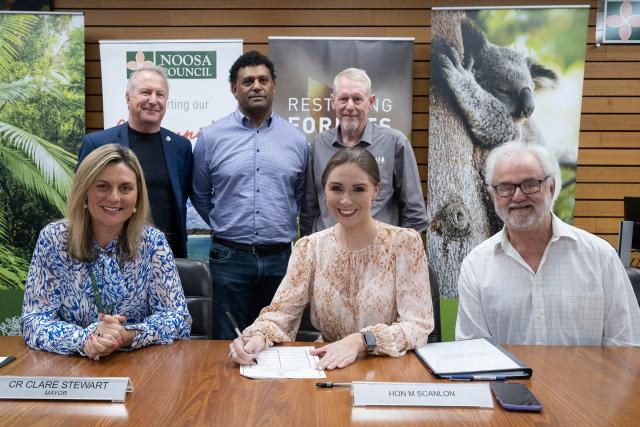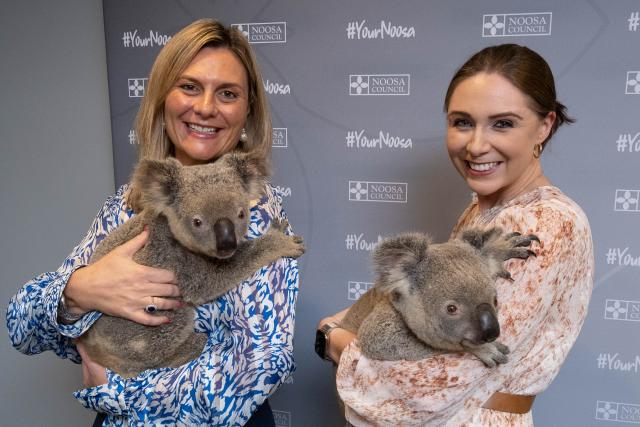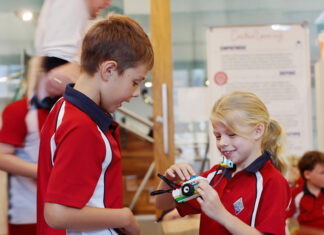
The ground-breaking and historic Yurol Ringtail Conservation Project was formally claimed by the Palaszczuk Government at Noosa Council chambers this week, in front of most of the conservationists and true believers who had worked since 2018 to make it happen.
But if there had ever been any friction over who did what in the process, it had long been forgotten as the key players joined in celebration of a project which effectively doubles the size of Noosa’s National Park estate, and nearly completes the crescent of perpetually protected national parks and wildlife corridors around our coastal built environment.
“This has been the happiest collaboration of governments, industry, conservationists and First Nations people that I’ve ever been involved with,” said Dr Michael Gloster, vice-president of Noosa Parks Association and acknowledged as the true architect of the acquisition plan.
Announcing that the project was now entering its final phase, Environment Minister Meaghan Scanlon said the Palaszczuk Government would now turn the 2400 hectares of the old Yurol Ringtail State Forest into national park, with major revegetation works to be carried out by the Kabi Kabi People Aboriginal Corporation, Greenfleet Australia and Noosa Landcare.
Ms Scanlon said it was a great example of collaboration between the state government, councils, First Nations’ communities, industry and environment groups like the Noosa Parks Association to rehabilitate the environment and sprout new employment and training opportunities as part of the state’s Covid-19 Economic Recovery Plan.
“Tewantin and Noosa national parks play an incredibly important role in the local environment and also bring in thousands of tourists every year to this area – so any chance to expand it will reap huge benefits for the community,” Ms Scanlon said.
“The final harvest of pine and hardwood plantation timber in the state forest is expected to be completed soon, and following that the plantation areas will be revegetated with native species and the restored habitat progressively added to Tewantin National Park.”
The transformation of ex-plantation state forests into national park through the Yurol Ringtail Conservation Project began in 2018 as a partnership between the Department of Environment and Science (DES), the Department of Agriculture and Fisheries (DAF), HQPlantations, Noosa Shire Council and Noosa Parks Association, with Council, State Government and the Parks Association equally funding the $3.5 million investment needed to secure the land.
Despite setbacks along the way, goodwill between the stakeholders ensured the project would not be derailed, particularly after they were joined by the Kabi Kabu First Nations and not-for-profit corporation, Greenfleet Australia.
Norman Bond, chair of the Kabi Kabi Peoples Aboriginal Corporation, said the project was important for the environment and the Traditional Owners.
“Kabi Kabi People look forward to working with Greenfleet and Noosa Landcare in providing training and future employment opportunities for our people and long-term protection of our country.
“Our goal now is to progressively increase the management role of Kabi Kabi people in working with Queensland Parks and Wildlife Service over our National Park country.”
Greenfleet Australia, who will invest up to $4.5 million in the project and will secure the exclusive right to benefit from associated carbon offsets for 30 years, have engaged Noosa and District Landcare to assist with tree propagation and planting when conditions on the ground are suitable.
Greenfleet chief executive officer Wayne Wescott said the corporation’s work combined climate action via ecosystem restoration with reconciliation which included financial, training and employment opportunities for the Kabi Kabi People.
“This project will reduce the impacts of climate change at an incredible scale- sequestering hundreds of thousands of tonnes of carbon emissions,” Mr Wescott said.
“Greenfleet is combining that with a direct revenue stream for Traditional Owners and jobs on Country for Kabi Kabi people in a rich and sustaining partnership of which Greenfleet is very proud.”
Mayor Clare Stewart said Noosa Council welcomed the support of Greenfleet, the Kabi Kabi people and Noosa District Landcare for the next phase of the Yurol Ringtail Conservation Project. “Revegetating the former timber plantation with native trees is a critical part of the project to help generate habitat for koalas and threatened species such as the Richmond birdwing butterfly and giant barred frogs,” she said.
“Transfer of rehabilitated forestry to Tewantin National Park will ultimately double the Park’s size and create a protected corridor to the Cooloola section of the Great Sandy National Park.
“Today, buoyed by the support of our new project partners, I can say that this is one of the most significant land conservation projects Noosa Shire has ever seen.”
Significant it surely is, but outside the stakeholders, few people in the community understand that significance, nor the complex plan that enabled Noosa’s crescent of green to happen.
In a special feature article next week, Noosa Today will look behind the scenes of the Yurol Ringtail Conservation Project.







